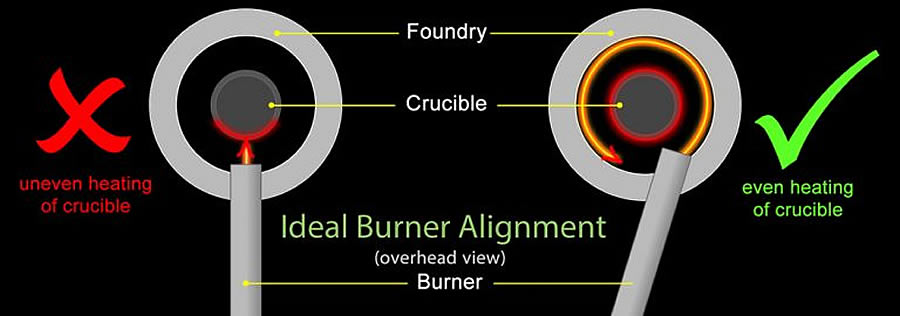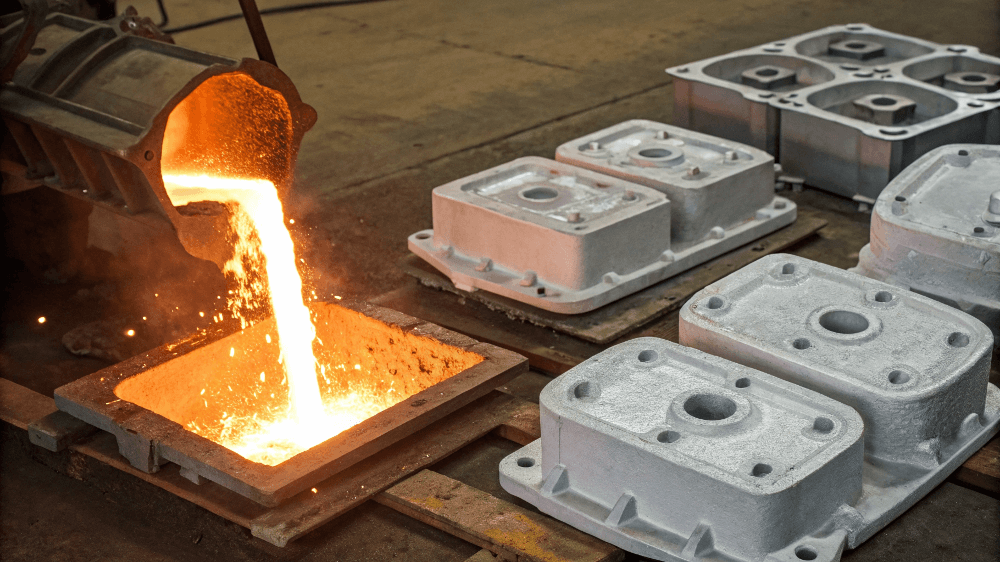Aluminum Foundry Wisconsin supports strong casting services
Just How Aluminum Foundry Adds To Improvements in Aerospace Design
Aluminum foundries are important to improvements in aerospace design. They generate light-weight, high-strength components that are important for contemporary airplane. Through advanced casting strategies, these factories create intricate geometries that improve architectural stability. In addition, the growth of superior Aluminum alloys sustains the industry's emphasis on gas efficiency and sustainability. Nevertheless, obstacles continue to be in the manufacturing procedure. Understanding these elements discloses the profound effect of Aluminum on aviation's future.
The Value of Lightweight Materials in Aerospace Layout
As the aerospace industry remains to advance, the relevance of light-weight materials ends up being significantly noticeable. The need for effectiveness and sustainability drives engineers to focus on the usage of materials that lower total weight without jeopardizing architectural honesty. Lightweight products, especially Aluminum, play a vital role in boosting fuel effectiveness, boosting payload capability, and raising the total efficiency of aircraft.
The integration of these materials permits for cutting-edge layouts, making it possible for suppliers to develop even more wind resistant forms that can hold up against severe problems. The decrease in weight not only decreases functional expenses but additionally adds to a decreased environmental footprint, lining up with global initiatives towards sustainability in aeronautics.
Advanced Casting Techniques in Aluminum Foundries
Advanced casting techniques in Aluminum shops play an important function in aerospace engineering by enabling the production of lightweight and exact elements. Developments in mold design and precision spreading procedures are essential in achieving perfect efficiency and structural integrity. In addition, the growth of lightweight alloys boosts the general efficiency and performance of aerospace applications.
Ingenious Mold Design
Ingenious mold layout plays an essential duty in the effectiveness and effectiveness of Aluminum shops, especially within the aerospace market. By leveraging sophisticated products and methods, modern mold and mildews can be crafted to stand up to heats and stress, making sure peak performance throughout the casting process. These styles often include complex geometries that permit the production of light-weight yet structurally sound elements, important for aerospace applications. In addition, the use of computer-aided design (CAD) software facilitates accurate modeling, enabling foundries to replicate and fine-tune mold designs prior to physical production starts. This not only boosts the high quality of cast parts but additionally reduces waste and preparation, resulting in significant expense financial savings. Overall, innovative mold and mildew layout is a cornerstone of development in Aluminum Foundry technology for aerospace engineering.
Precision Casting Procedures
The performance of innovative mold and mildew designs effortlessly integrates with precision casting procedures, which are crucial for generating premium Aluminum parts in aerospace design. These procedures, consisting of sand spreading, die casting, and investment casting, guarantee the development of complicated geometries with tight resistances. Advanced methods like vacuum spreading and pressure die casting improve the stability and surface area coating of the last products. Precision casting reduces material waste while maximizing the mechanical homes of Aluminum, crucial for aerospace applications. On top of that, utilizing real-time tracking and progressed simulation devices throughout the casting process permits immediate adjustments, leading to boosted quality assurance. Jointly, these accuracy casting processes placement Aluminum shops at the leading edge of aerospace advancement, supporting the industry's need for dependability and performance.
Light-weight Alloy Advancement
As aerospace engineers seek to enhance gas performance and efficiency, lightweight alloy development becomes a necessary focus in Aluminum shops. These shops utilize sophisticated casting strategies to produce alloys that provide premium strength-to-weight proportions. Advancements in alloy composition, consisting of the unification of aspects like lithium and magnesium, enable the manufacturing of materials that endure extreme problems while reducing total aircraft weight. Strategies such as die casting and financial investment casting facilitate the accuracy manufacturing of complicated shapes, which are essential for aerospace applications. Furthermore, ongoing research study aims to enhance these alloys for boosted mechanical residential or commercial properties and boosted sturdiness. By prioritizing light-weight alloy development, Aluminum factories substantially contribute to the development of aerospace design, paving the method for more effective and lasting airplane layouts.

Enhancing Architectural Honesty Through Aluminum Components
Aluminum parts supply significant advantages in enhancing structural integrity within aerospace engineering. Their lightweight nature contributes to general performance while maintaining strength, which is crucial for aircraft performance. Additionally, the anxiety resistance properties of Aluminum help guarantee the toughness and reliability of aerospace frameworks under numerous operational conditions.
Lightweight Material Perks
While traditional materials frequently endanger weight for stamina, using Aluminum components in aerospace engineering supplies substantial benefits in structural integrity. Aluminum's light-weight nature adds to general style effectiveness, enabling for more structured airplane that take in less gas, consequently improving sustainability. The material's superb strength-to-weight proportion warranties that elements maintain resilience without including unnecessary mass. This quality cultivates enhanced performance and agility in flight, along with enhanced haul capacities. In addition, Aluminum's resistance to deterioration extends the life expectancy of aerospace structures, lowering upkeep costs and enhancing safety. As suppliers increasingly take on Aluminum alloys, the aerospace market experiences a transformative change towards a lot more efficient and his comment is here reliable design options that prioritize both performance and ecological responsibility.
Anxiety Resistance Characteristics
Although various products possess unique buildings, Aluminum's exceptional tension resistance stands out as an important consider boosting the architectural honesty of aerospace components. This resistance plays an important function in making certain that aircraft can stand up to various operational tensions, including fatigue, influence, and environmental problems. Aluminum alloys, especially crafted for aerospace applications, exhibit high tensile toughness while keeping light-weight characteristics, enabling engineers to develop much more efficient structures - Aluminum Foundry. Furthermore, the ability of Aluminum to endure cyclic loading without significant deformation adds to the long life and integrity of aerospace parts. As advancements continue in Aluminum Foundry strategies, the development of stress-resistant Aluminum components promises additional renovations in efficiency, security, and effectiveness across the aerospace sector, solidifying Aluminum's duty as a preferred material in contemporary design
Fuel Efficiency Improvements Driven by Aluminum Innovations
As the aerospace industry looks for to improve gas effectiveness, innovative uses of Aluminum have actually arised as a crucial remedy. Aluminum's light-weight nature significantly minimizes aircraft weight, permitting for reduced gas usage during trip. This decrease in weight is crucial, as even small reductions can cause considerable renovations in overall fuel economy.
Advanced Aluminum alloys, made for improved toughness and durability, make it possible for makers to produce parts that preserve structural integrity while decreasing mass - Aluminum Foundry. Furthermore, the integration of Aluminum in airframes and engine parts assists in enhanced the rules of aerodynamics, adding to minimized drag and increased performance
The adoption of Aluminum in aerospace not just meets the demand for fuel-efficient layout however likewise straightens with regulatory pressures for reduced emissions. As these technologies remain to progress, they play a considerable duty in setting brand-new standards for fuel effectiveness, guaranteeing that the aerospace sector can fulfill growing environmental and financial obstacles.

The Function of Aluminum in Sustainable Aeronautics Practices
The increasing emphasis on sustainable aviation practices has positioned Aluminum as a crucial product in the mission for greener airplane layout. Recognized for its light-weight residential properties, Aluminum considerably reduces aircraft weight, resulting in lower fuel consumption and emissions. Its recyclability further boosts its sustainability account, as Aluminum can be reused forever without loss of high quality. This characteristic supports a round economy within the air travel industry, lessening waste and resource depletion.
Developments in Aluminum alloys have improved their toughness and deterioration resistance, enabling for longer service life and decreased upkeep demands. These advancements facilitate the development of extra effective airplane structures, adding to general sustainability efforts. In addition, Aluminum's thermal conductivity plays a crucial function in energy-efficient designs, improving systems such as heat exchangers. Jointly, these attributes emphasize Aluminum's critical role ahead of time lasting air travel, aligning with international campaigns intended at decreasing the ecological impact of flight.
Obstacles Encountered by Aluminum Foundries in Aerospace Manufacturing
While Aluminum foundries play an important function in aerospace production, they face considerable challenges that can affect production efficiency and high quality. One major difficulty is the rigorous high quality control standards called for in the aerospace market. Any problem can endanger security and performance, demanding extensive evaluation procedures that prolong manufacturing timelines. Additionally, foundries usually emulate varying basic material prices, which can affect pricing and profitability. The complexity of Aluminum alloys utilized in aerospace applications additional makes complex the production procedure, as precise formulas are vital for attaining desired mechanical properties. Skilled labor scarcities prevent the capability to preserve top notch production levels. Ecological regulations impose constraints on emissions and waste monitoring, calling for foundries to spend in sustainable practices, which can be cost-prohibitive. These aspects jointly produce a landscape where Aluminum foundries need to continuously adjust to fulfill the developing needs of aerospace production while making certain safety and compliance.
Future Fads in Aluminum Applications for Aerospace Engineering
With advancements in innovation and enhancing needs for efficiency, the future of Aluminum applications in aerospace engineering is positioned for significant change. The combination of ingenious Aluminum alloys and composites is anticipated to enhance strength-to-weight proportions, leading to even more fuel-efficient airplane styles. On top of that, improvements in additive production techniques will certainly enable for the production of intricate Aluminum structures that were formerly impossible, enhancing efficiency and minimizing waste.

Sustainable methods will certainly play a vital duty, with an expanding emphasis on recycling great site Aluminum to decrease environmental effect. The aerospace market is most likely to welcome smarter making procedures, such as automation and expert system, guaranteeing higher high quality and precision in Aluminum elements. Moreover, collaborations between Aluminum shops and aerospace business will certainly cultivate study and growth, leading the means for new applications that meet the rigid needs of modern-day aerospace design - Aluminum Foundry. In general, the future looks promising for Aluminum's function fit the skies
Regularly Asked Inquiries
What Are the Environmental Influences of Aluminum Production in Aerospace?
The ecological effects of Aluminum production in aerospace consist of significant energy usage, greenhouse gas discharges, and habitat disturbance. Additionally, mining processes can lead to dirt destruction and water contamination, increasing worries about check sustainability and ecological equilibrium.
Just How Does Aluminum Contrast to Other Products in Aerospace Applications?
Aluminum uses a special combination of light-weight residential or commercial properties, corrosion resistance, and cost-effectiveness contrasted to other products. Its high strength-to-weight ratio makes it specifically useful for aerospace applications, improving gas effectiveness and overall efficiency in aircraft style.
What Qualifications Do Aluminum Foundry Employees Need for Aerospace Projects?
Aluminum Foundry employees need specialized training in metallurgy and spreading techniques, together with understanding of aerospace market standards. Certifications in quality control and safety and security protocols are additionally important to assure conformity with stringent aerospace job requirements.
Are There Any Kind Of Safety And Security Issues With Making Use Of Aluminum in Aerospace Engineering?
Safety problems concerning Aluminum in aerospace design include sensitivity to stress, tiredness, and deterioration cracks. Proper treatment and alloy option are necessary to minimize these risks, guaranteeing structural stability and overall safety in aerospace applications.
Exactly How Does Aluminum Recycling Advantage the Aerospace Sector?
Aluminum reusing greatly benefits the aerospace industry by reducing material prices, reducing environmental effect, and saving energy. This lasting method improves the market's performance while advertising using light-weight, high-performance parts in airplane manufacturing.
Advanced casting methods in Aluminum foundries play an important duty in aerospace design by allowing the production of accurate and light-weight components. Ingenious mold layout plays an essential function in the effectiveness and efficiency of Aluminum shops, especially within the aerospace industry. As aerospace engineers seek to improve fuel performance and efficiency, lightweight alloy development comes to be a crucial emphasis in Aluminum foundries. Aluminum alloys, specifically crafted for aerospace applications, display high tensile strength while keeping lightweight attributes, allowing engineers to design extra effective structures. Partnerships between Aluminum shops and aerospace business will promote research and growth, paving the method for brand-new applications that meet the rigid requirements of modern-day aerospace engineering.